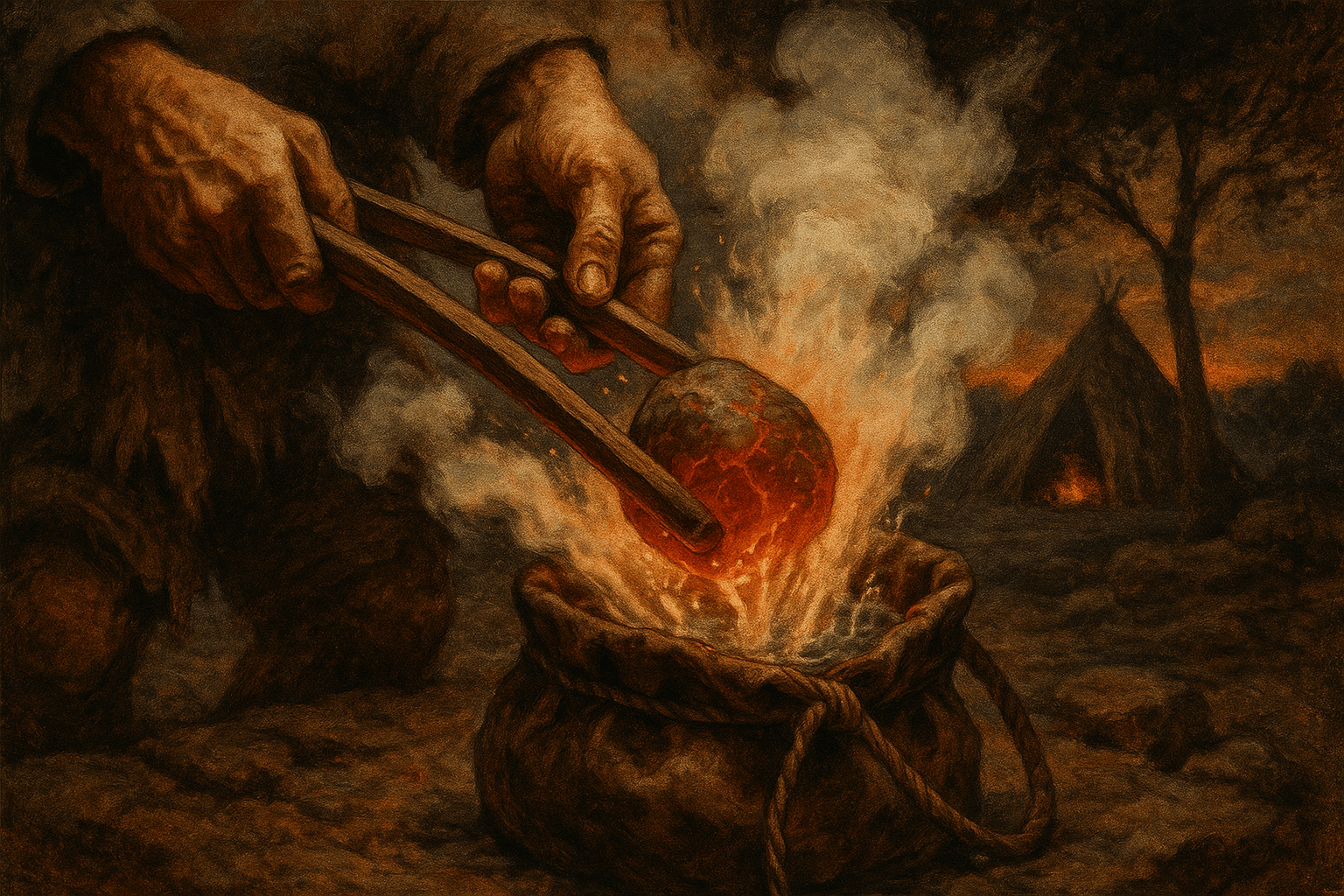This ancient culinary technique, which relied on “feeding” hot stones to water, offers a fascinating glimpse into a world before the pot, revealing the resourcefulness, social structures, and daily life of our prehistoric ancestors.
The Ingenuity of the ‘Stone-Eaters’
So, what exactly is stone-boiling? The principle is a brilliant application of basic physics: heat transfer. Since early Neolithic people lacked containers that could withstand direct flame, they couldn’t place a vessel *over* a fire. Instead, they brought the fire *to* the vessel.
The process was methodical and labor-intensive:
- The Hearth: First, a large fire was built to heat a carefully selected collection of fist-sized, dense stones. Not just any rock would do; they had to be of a type (like quartzite or sandstone) that could absorb immense heat without exploding.
- The Vessel: Nearby, a container was filled with water. This wasn’t a pot, but often a pit dug into the ground, a trough carved from a large log, or even a flexible bag made of animal hide propped up with stakes. In clay-rich soils, the pits themselves might be lined with puddled clay to make them watertight.
- The Transfer: Once the stones in the fire were glowing hot, they were deftly plucked out using tongs made from green, unseasoned wood (which wouldn’t catch fire immediately).
- The Boil: These scorching stones were then dropped directly into the water-filled pit or bag. The result was immediate and dramatic: the water would hiss, steam, and quickly come to a rolling boil as the stones released their stored thermal energy.
As the stones cooled, they were replaced with a fresh, hot batch from the fire, allowing the “chef” to maintain a consistent simmer for hours. The pits and troughs, filled with cooling, cracked stones at the end of the process, are what archaeologists sometimes poetically refer to as ‘stone-eaters’—the stationary ancestors of the modern cooking pot.
Reading the Rocks: The Archaeological Evidence
We know about this forgotten technique thanks to the incredible durability of its main ingredient: stone. Across Northern Europe, thousands of mysterious mounds of burnt, fire-cracked rock have been discovered, often in damp, low-lying areas near streams or springs. In Ireland, they are famously known as fulachtaí fia (a Gaelic term loosely translated as “cooking places of the deer” or “of the wild”). For centuries, jejich purpose was debated; folk tales suggested they were bath-houses for ancient warriors or sites for dyeing cloth.
Modern archaeology and experimental reconstructions, however, have confirmed their primary function was culinary. A typical fulacht fia site consists of three key features:
- A central trough or pit where the boiling took place.
- A nearby hearth where the stones were heated.
- A crescent-shaped or U-shaped mound of discarded, fire-cracked stones.
This mound is the accumulated waste of countless cooking sessions. After being heated and plunged into cold water multiple times, the stones would eventually fracture and crumble, losing their ability to hold heat effectively. They were then cleared out of the trough and tossed aside, gradually forming the distinctive burnt mounds we find today—a prehistoric kitchen midden made of stone.
A Menu from the Stone Age Kitchen
Stone-boiling wasn’t just a novelty; it fundamentally changed what people could eat. This technique was perfect for making broths and stews, which are fantastic ways to extract every last calorie and nutrient from food.
By boiling meat, even the toughest cuts and sinewy joints could be rendered tender and digestible. Bone marrow, a crucial source of fat and nutrients, could be easily extracted by boiling cracked bones. Animal bones frequently found at these sites—from deer, wild boar, and even the massive aurochs—suggest hearty stews were a staple. It’s likely they also added wild vegetables, tubers, and grains to the bubbling water, creating a complete and balanced meal.
This method was essentially a slow cooker, allowing large quantities of food to be prepared over several hours. For a hunter-gatherer or early farming community, the ability to turn a challenging carcass into a nourishing, easily shared liquid meal was a major advantage.
More Than Just a Meal: The Social Hub
The scale of many stone-boiling sites suggests they were more than just family kitchens. The labor involved in digging a pit, gathering wood, collecting stones, and managing the process for hours points toward communal activity. These spots were likely social hubs, places where a group—perhaps a hunting party returning with a large kill or a community gathering for a seasonal feast—would come together to collectively prepare and share food.
While cooking was the primary purpose, the vast quantities of hot water produced could have been used for other things. These sites might well have been multi-purpose “processing plants” for the community, used for bathing, processing hides, dyeing textiles with plant-based colors, or even brewing a rudimentary form of ale—a popular theory, though harder to prove archaeologically.
The End of an Era: The Arrival of the Pot
So if stone-boiling was so effective, why did we stop? The answer lies in the arrival of a revolutionary new technology: pottery. As knowledge of ceramics spread into Northern Europe during the later Neolithic and Bronze Age, it represented a paradigm shift in daily life.
A simple clay pot could be placed directly over a fire. It was portable, easier to clean, and required far less fuel and preparation than a full stone-boiling operation. While the old method didn’t disappear overnight—it was likely still used for very large-scale cooking events—the convenience of the pot gradually made stone-boiling obsolete for everyday use.
The age of the ‘stone-eaters’ drew to a close. The burnt mounds were slowly covered by earth and time, their purpose forgotten until they were rediscovered by modern archaeologists. Today, they stand as silent monuments to human ingenuity, a reminder that for thousands of years, our ancestors created rich, hot meals not with a pot on a fire, but with a fire in a pot of stone.
